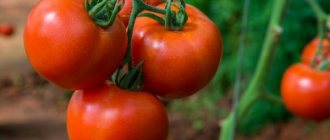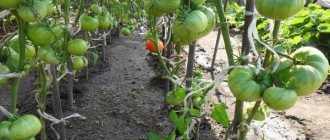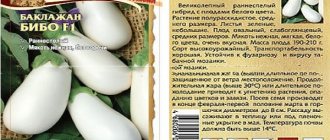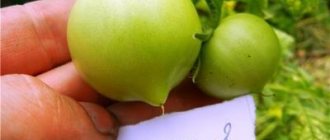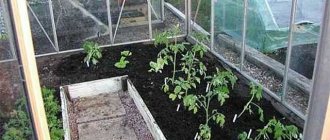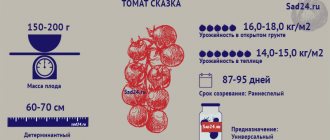The tomato variety “Babushkin Secret” was registered in the State Register in 2007 and is recommended for cultivation in greenhouses or open ground in all climatic zones of the country. Russian summer residents, who have been growing this variety of tomatoes for many years, speak very positively about it. Our article is intended to better acquaint gardeners with the plant and its properties.
Russian summer residents, who have been growing this variety of tomatoes for many years, speak very positively about it
The main characteristics of the variety are given in the table:
| Parameter | Characteristic |
| Culture | Tomato (Solanum lycopersicum L. var. lycopersicum) |
| Ripening period | Mid-season |
| Period from germination to fruiting | 110-115 days |
| Marketable yield | 16.9 kg/m2 (under film covers); up to 3 kg from 1 bush |
| Fruit weight | Average 354 g (maximum – up to 700 g) |
| Form | Flat-round, ribbed |
| Coloring of ripe fruits | Pink |
| Skin | Thin |
| Pulp | Thick, sugary, juicy, aromatic |
| Number of slots | More than 6 |
| Taste qualities | Excellent |
| Transportability and keeping quality | Low |
| Purpose | Salad, suitable for processing into juice |
| Plant type | Indeterminate, tall (up to 100 cm in open ground, up to 150-200 cm in greenhouses) |
| Leaves | Large, dark green |
| Inflorescence | Simple |
| Features of cultivation | Requires staking and plant formation |
| Disease resistance | The variety is weakly resistant to pathogens of major crop diseases |
| Recommended growing regions | All regions (in open ground and under film covers) |
| Year of registration in the Federal State Budgetary Institution "State Varietation Commission" | 2007 |
| Originator | Postnikova Tatyana Nikolaevna |
Main characteristics
This is a variety of unlimited growth. It is a typical large-fruited salad tomato. Under growing conditions in protected soil, the height of the bushes reaches 2 meters, in beds - 1 meter. The stem is not so powerful, it is distinguished by moderate formation of shoots and average foliage. The leaves are the most common size, tomato type, dark green in color, slightly wrinkled. The inflorescence is of a simple type, up to 8 of them are formed on the main stem, each with about 5 ovaries, sometimes more.
To ripen large tomatoes, experts recommend leaving only 2-3 flowers. The ripening period of tomatoes is about 110 days from the moment the first shoots appear.
Description of fruits
The fruits of the Babushkin Secret variety are very impressive. When ripe, they are large in size and pink in color, flat-round in shape and pronounced ribbing. The weight remains at approximately 350 grams, but under favorable conditions it reaches 700 grams.
The skin of the fruit is thin and glossy. The pulp is quite dense, it has a rich taste and a characteristic tomato smell. It is meaty and not too watery, some even find it dry. There aren't that many seeds. At the same time, the seed chambers themselves are small, there are at least 6 of them.
The taste is wonderful, but to enjoy it, you have to wait for the tomatoes to fully ripen. If you want to grow a fruit weighing a kilogram, then you need to strictly limit the number of stems and leave only one flower in the cluster. Also, for this, the crop needs careful feeding.
According to official descriptions, tomatoes are recommended for fresh consumption; they are suitable for raw salads and sandwiches. When heat treated, the fruits do not lose their quality. They are good for soups and main courses. Preservation is acceptable if the tomatoes are chopped. You can make tomato paste. Some housewives make juice from them, but harvesting on a large scale is impossible.
Diseases and pests
The variety is susceptible to diseases and pests typical of tomatoes. His immunity is normal, but sometimes problems still occur.
Late blight
This is a fungal disease that can cause enormous damage to crops. Brown spots appear on the foliage and stems. They increase over time, especially if the humidity level is very high. Subsequently, the spots spread to the fruits themselves.
To prevent late blight, preventive treatment should be carried out before transplanting seedlings into the ground. Chemical and biological preparations are intended for treatment.
Tomato mosaic
The disease is caused by a virus. It can kill huge amounts of crops. Typically, the disease is typical for tomatoes planted in open ground, but it can also occur in those growing in a greenhouse. Affected plants have a specific mosaic pattern. Individual areas on the leaves darken, and the foliage itself curls. Over time, the spots spread to the fruit.
To prevent the disease, you should select those seeds that are immune to the virus. In addition, before planting, it is recommended to pickle them in a 1% solution of potassium permanganate (20 minutes). Sick bushes are removed from the garden and disposed of.
Fomoz
Phoma attacks both unripe and ripe fruits. A characteristic symptom is a brown spot next to the stalk. Over time it increases in size, but not too much. The rot mainly spreads inside the fruit.
For prevention, the soil and greenhouse should be disinfected. Phomasis can be treated with the following drugs: Fundazol, Zaslon, Bordeaux mixture. Diseased fruits are collected and disposed of.
Aphid
Aphids attack young and tender foliage. In addition, it can transfer viruses from one plant to another. It cannot be ignored due to its high fertility. She can quickly take over literally the entire dacha plot.
For prevention, it is worth collecting and destroying any plant debris in a timely manner, as well as planting crops with a pungent odor near the tomato. You can get rid of aphids using Karbofos, a solution of laundry soap or Fitoverm.
Brown spot
Fungal disease is most relevant for plants located in a greenhouse. Brown spots with plaque appear on the leaves. Over time, the foliage dies, which can provoke the death of the entire bush.
It is worth noting that the fungus can spread to other plants. After harvesting, the soil and greenhouse should be disinfected using a solution of copper sulfate prepared in a proportion of 1 cup per 10 liters of water. It is also important to observe crop rotation. Experts also advise selecting tomato seeds that are resistant to this disease.
Features of cultivation
Seed preparation
Before planting seedlings, it is important to prepare the seed material. The variety has good germination, but to avoid misunderstandings, it is recommended to discard bad seeds
The grains are placed in a saline solution. All seeds that settle at the bottom of the liquid are suitable for planting. Those remaining on the surface must be discarded.
Then the seeds are placed for disinfection in a solution of potassium permanganate. This will prevent the development of many diseases in the future. The seeds are kept in the solution for 10 minutes.
Planting seedlings
It is necessary to prepare the soil. It must be fertile. Prepare the soil yourself or purchase it in stores. If soil from the garden is to be used, it is doused with boiling water in advance to destroy pathogenic bacteria.
The containers are filled with soil, and the seeds are planted to a depth of 0.5-1 cm. They are sprinkled with soil, watered, and then the containers are covered with film and placed in a warm place.
When sprouts appear, the film is removed and the containers are placed in a sunny place.
When 3-4 true leaves appear on the plants, the crop is picked. Each bush is planted in a separate pot.
2 weeks after planting the seedlings, it is recommended to feed them with mineral fertilizers. It is also necessary to regularly water the plants every 2-3 days.
Don’t forget about hardening off the seedlings. As soon as the average air temperature outside is +8 - +10 degrees, the seedlings are placed on the balcony during the daytime. When the night temperature is within +5 degrees, the seedlings can be left on the balcony overnight.
Planting tomatoes in the ground
Before planting seedlings in open ground, it is recommended to properly prepare the beds. Add organic matter: manure, compost, sawdust or rotted straw. The earth is carefully dug up to a depth of 20-25 cm.
Holes are made in the ground to such a depth that after planting the plant’s root collar is completely covered with soil. Plants are placed in holes, sprinkled with soil and compacted. Carry out abundant watering. For the first time, all plantings are covered with film. The film can be removed from the beds in mid-June.
It is necessary to maintain distance between plantings. There should be a distance of at least 20 cm between plants. If plants are planted in rows, the distance between them should be 40-50 cm.
Advantages and disadvantages
Like any other variety, Grandma's Secret has its pros and cons. First of all, you should consider the advantages:
- large fruits;
- excellent taste;
- high productivity;
- good immunity;
- You can store the crop for quite a long time
Flaws:
- fruits may crack;
- isolated cases of illness.
Landing
Growing tomatoes is not difficult even for beginners. To sow seeds, use turf soil mixed with humus or sand. In addition, you can purchase ready-made soil in the store. Before sowing, both the soil and planting material are thoroughly cultivated (soaked in potassium permanganate).
Seeds are deepened into moist soil to a depth of 2 centimeters. Then the container is placed on the window on the sunny side, the optimal temperature is +25 degrees. The box is covered with cellophane film. As soon as the first sprout emerges, it is removed and the temperature is reduced to 16 degrees.
When the first two true leaves appear, the tomatoes are planted one at a time (dive). Transplantation must be done very carefully so that the roots are not injured. The plants are moved to a permanent location when they are 50 days old. Two weeks before transplantation, hardening begins.
The soil is dug up and fertilizers are added, after which it is watered with a solution of potassium permanganate. The holes are placed at a distance of 50 centimeters from each other. Immediately after planting, the bushes are tied to supports.
How to grow
There is no secret to growing super-large tomatoes. You need to germinate seeds for seedlings in soil made from turf soil, humus and sand. If you do not want to prepare such a soil mixture yourself, you can buy it at the store. It is also possible to germinate seeds in peat tablets. This option is suitable if you need few seedlings.
Before planting, the seeds and soil need to be prepared. First, pour boiling water with a small amount of manganese into the soil. This must be done in order to disinfect the soil and prevent diseases. Next, soak all the seed in a weak solution of potassium permanganate or Zircon; this can also be done in Kornevin.
Carefully place the seeds in the container so that the distance between them is 2 cm. The soil should be very moist. Spread a 2cm layer of soil evenly over the seeds.
Place the container with the seed in a warm, well-lit place. It is advisable that the ambient temperature be 25 degrees, then this will be the best place for growing. To speed up seed germination, cover the container with transparent film.
After the first shoots appear, remove the film and place the container in a cooler place. This is done so that the seedlings do not stretch too much. If possible, at this time, provide your crops with an ambient temperature of about 16 degrees.
As soon as two leaves are formed on the sprouts, transplant them into separate peat cups.
Seedlings can be planted in the soil no earlier than 50 days after planting the seeds. A week before planting, start hardening off the seedlings. To do this, simply take it out into the open air, and leave it there longer every day.
Water the soil generously with a hot solution of potassium permanganate, mark places for the holes in which the cups with seedlings will be placed. The distance between the holes and rows should be at least 50-60 cm. With a denser arrangement, the tomato bushes will be crowded in the garden bed, and in this case you will not get a good harvest.
The seedlings grow very tall, so immediately after transplanting them into the ground, tie the stems to reliable supports.
Giant tomatoes Grandma's Secret do not like high humidity. In this case, the fruits may crack. Therefore, water your tomatoes sparingly but regularly. Usually this has to be done once a week.
After each watering, the soil around the bushes must be loosened and weeds must be pulled out, if they appear, of course. Ventilate greenhouses regularly and prevent perspiration from appearing inside. Air that is too humid is harmful for this variety of tomatoes.
Care
Plants need to be provided with systematic watering, but you should not flood the soil too much - this will have a negative impact on them. A drip system that supplies moisture specifically to the root system is especially relevant. In addition, the soil must be constantly weeded to remove weeds. If tomatoes grow in a greenhouse, then it is necessary to ventilate it sometimes.
This variety is grown in one stem. Any stepsons and foliage must be removed first up to the first cluster, and then as the bushes are tied. As soon as the eighth flower cluster appears on the stem, it is pinched, stopping further growth. Thanks to this, the crop will be able to grow larger fruits.
At the end of summer, you should pick off browned fruits, and if there is a threat of severe cold, green ones. If the tomatoes are of normal size, they can ripen on their own if stored properly.
If in open ground flowers are pollinated by flying insects, then in greenhouses the bushes should be shaken periodically, after spraying the flowers with water.
Transplanting seedlings into the ground
Tomatoes need good care
Based on the characteristics of the variety, which does not tolerate night frosts well, transplantation into open ground or a greenhouse is carried out in the middle or end of May. During this time, the soil and air will warm up to the optimal temperature for tomatoes (10-15 ° C). The beds are inspected and all weeds and foreign objects are removed from them.
The planting pattern should be 60x60 cm. The depth of the hole is 20-25 cm. 1 tbsp is poured onto the bottom. l. superphosphate. This is necessary so that the plants can resist possible frosts and the moisture level inside the soil is regulated. Precise adherence to the rules of agricultural technology will help you.
- Fertilizer is mixed with soil.
- Place the seedlings vertically and cover them too.
- Compact the soil around the seedlings to prevent voids from forming inside the root system.
- Water the bushes with 3 liters of warm water.
Reviews
Dmitry Ivanovich, Volgodonsk : I devote a lot of time to my dacha. I often try new varieties of vegetables. Recently, a neighbor gave me some Grandmother's Secret seedlings. I harvested my first harvest just recently. The fruits are good both fresh and in salads. The amount we received was just enough for our family. I won’t do any seaming for the winter - firstly, we’ll finish everything, and secondly, it seems to me that the variety is not very suitable for them. And so, I’m happy with the tomato. I recommend them to everyone who loves them.
Anastasia Sinitsyna, Voronezh : I really like the Babushkin Secret variety. I grow it in a greenhouse. I will note that it is not too demanding to care for, and I have never gotten sick (but I carefully treat the room and soil). The harvest was huge, several buckets. The fruits are large, tasty, juicy. Not dry. I will continue to grow this tomato, it’s very cool.
Valery Fastin, Kharkov region. : I have been growing Grandma’s Secret for several years now, both in a greenhouse and in open ground. In the greenhouse my harvest is always stable, but in the open ground its quantity always depends on the weather. In the heat, everything is much worse, and in dampness the bushes immediately begin to hurt. But I really like the variety. I recommend it to all summer residents.
Tomato Grandma's secret: history of the variety
Tomato Grandma's secret: photo of variety
It is difficult to find a person who would not prefer to eat tomatoes in one of the various options, for example, raw, in the form of a salad, or after heat treatment. If we take into account summer residents, then they make every effort to choose a variety of tomatoes with different fruit sizes.
- The Babushkin Secret tomato variety is of Siberian origin; it was obtained by selection specialists Dederko and Postnikov from Siberia in two thousand and seven.
- The tomato variety Babushkin Secret was placed in the State Register of the Russian Federation. It is recommended to plant tomatoes in open soil only in warm parts of Russia, and in other parts of our country it is recommended to plant tomatoes in a greenhouse or under cover with a dense film.

